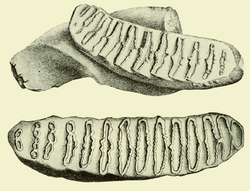Biology:Loxodonta atlantica
| Loxodonta atlantica Temporal range: Late Pliocene to Middle Pleistocene
| |
|---|---|

| |
| Scientific classification | |
| Domain: | Eukaryota |
| Kingdom: | Animalia |
| Phylum: | Chordata |
| Class: | Mammalia |
| Order: | Proboscidea |
| Family: | Elephantidae |
| Genus: | Loxodonta |
| Species: | †L. atlantica
|
| Binomial name | |
| †Loxodonta atlantica Pomel, 1879
| |
Loxodonta atlantica is an extinct African species of elephant in the genus Loxodonta (which includes living African elephants). It was larger than modern African elephants, with more progressive dentition.[1] It includes Pleistocene fossils from Ternifine, Algeria[2] Middle Pleistocene fossils from Elandsfontein, South Africa and Late Pliocene fossils from the Omo River, Ethiopia[3] It is suggested to have an extinction date of around 400,000 years ago, during the Middle Pleistocene.[4] L. atlantica has been suggested to have probably derived from L. adaurora;[5] or L. exoptata.[6] It is likely ancestral to the living African bush elephant, L. africana,[6] which it coexisted with during the Middle Pleistocene prior to its extinction.[3] The species is divided into two subspecies: L. atlantica atlantica (northern Africa) and L. atlantica zulu (southern Africa).[5] The type for Loxodonta atlantica is housed in the Muséum national d'histoire naturelle in Paris, but is listed without a specimen number.[6]
References
- ↑ Owen-Smith, R. Norman (1988). Megaherbivores: the influence of very large body size on ecology. Cambridge University Press. ISBN 0-521-36020-X.
- ↑ Geraads, D. (1987). "Dating the Northern African cercopithecid fossil record". Human Evolution 2: 19–27. doi:10.1007/BF02436528. http://doc.rero.ch/record/13360/files/PAL_E95.pdf.
- ↑ Jump up to: 3.0 3.1 Carruthers, Jane et al. (2008). "The Elephant in South Africa: History and Distribution". in Scholes, R. J.; Mennell, K. G.. Elephant management: A Scientific Assessment for South Africa. Wits University Press. pp. 23–83. doi:10.18772/22008034792. ISBN 978-1-86814-479-2. http://www.elephantassessment.co.za/files/03_ch1_Elephant%20Management.pdf.
- ↑ Stewart, Mathew; Louys, Julien; Price, Gilbert J.; Drake, Nick A.; Groucutt, Huw S.; Petraglia, Michael D. (May 2019). "Middle and Late Pleistocene mammal fossils of Arabia and surrounding regions: Implications for biogeography and hominin dispersals" (in en). Quaternary International 515: 12–29. doi:10.1016/j.quaint.2017.11.052. https://ora.ox.ac.uk/objects/uuid:c56e5ff6-d4d2-44f7-a96a-8f4f8a7ae1c9/files/me71e953cd3bd551906c0a5a752c5cf79.
- ↑ Jump up to: 5.0 5.1 Coppens, Y.; Maglio, V. J.; Madden, C. T.; Beden, M. (1978). "Proboscidea". in Maglio, V. J.; Cooke, H. B. S.. Evolution of African mammals. Cambridge MA: Harvard University Press. pp. 336–367. ISBN 0-674-27075-4.
- ↑ Jump up to: 6.0 6.1 6.2 Todd, Nancy E. (2010). "New Phylogenetic Analysis of the Family Elephantidae Based on Cranial‐Dental Morphology". The Anatomical Record: Advances in Integrative Anatomy and Evolutionary Biology 293 (1): 74–90. doi:10.1002/ar.21010. PMID 19937636.
Wikidata ☰ Q6694297 entry
 |

